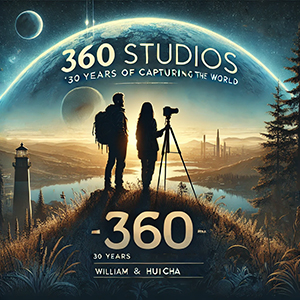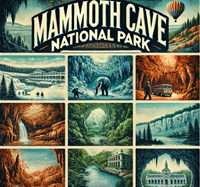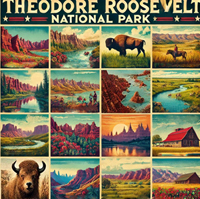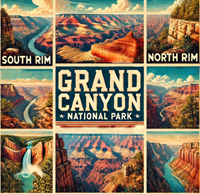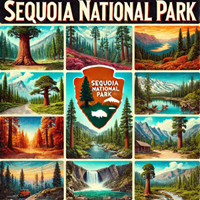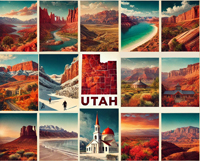

William and Hui Cha Stanek have meticulously crafted these national park guides, each showcasing the most stunning landscapes across the USA. But beyond the breathtaking scenery, these guides delve into the stories, experiences, and connections that make each park visit truly memorable.
National Parks Index | US Itineraries Index | American Roadtrips Index

Bring home a Bugville Critters book and watch as your child's love for reading and learning grows with every page. Hand-painted illustrations bring the heartwarming stories to life. Ask your librarian to add Bugville Critters to the library's digital collection today!
Discover William Stanek's Exclusive Art Collection
Explore and purchase the stunning art featured on this site. Own a piece of William Stanek's unique and captivating artwork today!
(January 27, 2025) Introducing Great Basin National Park: A Hidden Nevada Treasure
Introduction to Great Basin National Park
Great Basin National Park is a land of contrasts, where the rugged peaks of the Snake Range rise above the vast desert floor, and ancient bristlecone pines stand as silent witnesses to the passage of time. One of my favorite experiences in Great Basin was exploring the Lehman Caves, with their intricate formations and delicate beauty hidden beneath the earth' s surface. The park' s remoteness offers a sense of solitude that is hard to find elsewhere, and stargazing here, under some of the darkest skies in the country, was a magical experience. Great Basin is a place that invites you to slow down and appreciate the subtle beauty of the desert, where every rock and tree has a story to tell.
How to Reach Great Basin National Park
From the North (Salt Lake City, UT): Travelers can drive south on Interstate 15, then take US-6 west to US-50 west towards Ely. From Ely, follow US-6 west to Baker, Nevada, and then take NV-487 south to the park. This journey covers approximately 240 miles and takes around 4 hours.
From the South (Las Vegas, NV): Visitors from Las Vegas can take Interstate 15 north to US-93 north, then follow NV-487 north to the park. This route covers around 300 miles and takes approximately 5 hours.
From the East (Denver, CO): Those coming from Denver can take Interstate 70 west to US-50 west, then follow US-93 south to Ely, Nevada, and finally take NV-487 south to the park. This journey spans around 600 miles and takes about 10 hours.
From the West (Reno, NV): Travelers from Reno can drive east on Interstate 80 to US-93 south, then take US-50 east to Ely and NV-487 south to the park. This route covers approximately 330 miles and takes around 6 hours.
Exploring Great Basin: Must-Visit Sites
- Wheeler Peak: The park's highest peak, offering breathtaking views and challenging hikes.
- Lehman Caves: Stunning limestone caves with intricate formations, open for guided tours.
- Bristlecone Pine Grove: Home to some of the world's oldest living trees.
- Stella Lake: A serene alpine lake providing beautiful photographic opportunities.
Seasonal Variations
Great Basin's remote location means it offers beauty in every season:
- Spring: Melting snow and blooming wildflowers create picturesque landscapes.
- Summer: Warm days and cool nights make for ideal hiking and camping conditions.
- Fall: Vibrant fall foliage provides stunning color contrasts against the rugged terrain.
- Winter: Snow-covered peaks and serene landscapes offer solitude and winter sports opportunities.
Visitor Updates for Great Basin National Park
Conservation Efforts
William Stanek's work in Great Basin National Park highlights the park's unique and fragile ecosystems. His photography advocates for the preservation of ancient bristlecone pines and the pristine alpine environment, emphasizing the need for continued conservation efforts to protect this hidden treasure.
1 Day at Great Basin National Park: Nevada's Hidden Gem
Introduction
Great Basin National Park, located in eastern Nevada, offers stunning vistas of the Basin and Range region, ancient bristlecone pines, and the fascinating Lehman Caves. Here's a detailed guide to making the most of your visit, with expert tips from William and Hui Cha Stanek.
Morning: Sunrise and Scenic Drive
6:00 AM - Sunrise at Wheeler Peak
- Overview: Start your day with a breathtaking sunrise at Wheeler Peak, the second-highest peak in Nevada.
- Tips from William: Arrive early to set up your tripod and capture the sunrise over the expansive Great Basin. Use a wide-angle lens to encompass the entire landscape.
- Insights from Hui Cha: Dress warmly and bring a thermos of hot coffee or tea. The early morning air can be brisk.
7:30 AM - Breakfast at the Visitor Center
- Overview: Head to the Great Basin Visitor Center for a quick breakfast and to gather information about the park.
- Tips from William: Capture the morning light on the surrounding mountains and visitor center architecture.
- Insights from Hui Cha: Grab some snacks and water for the day. Check in with the rangers for any updates on trail conditions and weather forecasts.
Mid-Morning: Lehman Caves and Bristlecone Pines
8:30 AM - Lehman Caves Tour
- Overview: Join a guided tour of Lehman Caves, a marble cave known for its stunning formations.
- Tips from William: Use a tripod and a camera with a good low-light performance to capture the intricate stalactites and stalagmites.
- Insights from Hui Cha: Wear a light jacket as it can be cool inside the cave. Listen to the guide's fascinating stories about the cave's history and geology.
10:00 AM - Bristlecone Pine Trail
- Overview: Hike the Bristlecone Pine Trail to see some of the oldest trees in the world.
- Tips from William: Use a macro lens to capture the unique textures of the ancient bristlecone pines. Mid-morning light is ideal for photography.
- Insights from Hui Cha: Wear sturdy hiking shoes and bring plenty of water. The trail is moderately strenuous but offers rewarding views.
Afternoon: Alpine Lakes and Scenic Views
12:00 PM - Picnic Lunch at Wheeler Peak Campground
- Overview: Enjoy a picnic lunch at Wheeler Peak Campground with stunning mountain views.
- Tips from William: Capture candid moments of your picnic with the beautiful backdrop of the peak.
- Insights from Hui Cha: Pack a nutritious and energizing meal. Take a moment to relax and enjoy the serene environment.
1:00 PM - Alpine Lakes Loop Trail
- Overview: Hike the Alpine Lakes Loop Trail, which takes you to Stella Lake and Teresa Lake.
- Tips from William: Use a polarizing filter to reduce glare on the lakes and enhance the colors of the water and surrounding landscape.
- Insights from Hui Cha: The hike is relatively easy and offers beautiful views. Bring a light jacket as it can be cooler at higher elevations.
3:00 PM - Wheeler Peak Scenic Drive
- Overview: Drive the Wheeler Peak Scenic Drive, which offers stunning views of the park and surrounding areas.
- Tips from William: Use a telephoto lens to capture the distant peaks and valleys. Late afternoon light enhances the textures and colors of the landscape.
- Insights from Hui Cha: The drive is winding and can be narrow in some places, so take it slow and enjoy the views.
Late Afternoon: Photography and Relaxation
4:30 PM - Mather Overlook
- Overview: Stop at Mather Overlook for panoramic views of the park.
- Tips from William: Use a wide-angle lens to capture the vastness of the Great Basin. Experiment with different compositions and perspectives.
- Insights from Hui Cha: This is a perfect spot to relax and take in the scenery. Bring a snack and enjoy the view.
Evening: Sunset and Dinner
6:00 PM - Sunset at Lexington Arch
- Overview: Head to Lexington Arch for a stunning sunset view.
- Tips from William: Use a graduated neutral density filter to balance the exposure between the sky and the foreground. Capture the arch with the setting sun.
- Insights from Hui Cha: Arrive early to find a good spot. Bring a blanket and some snacks to enjoy while waiting for the sunset.
8:00 PM - Dinner in Baker
- Overview: Return to the nearby town of Baker for a relaxing dinner at a local restaurant.
- Tips from William: Capture the evening atmosphere of the small town. Try some local cuisine to end your day.
- Insights from Hui Cha: Reflect on the day's adventures and enjoy a hearty meal. Baker offers a charming and friendly dining experience.
Great Basin National Park (Nevada)
Great Basin National Park, located in eastern Nevada near the Utah border, is a lesser-known gem that offers stunning landscapes, ancient bristlecone pines, and the majestic Wheeler Peak. Covering over 77,000 acres, the park provides a tranquil and remote destination for those seeking to escape the crowds and explore the beauty of the Great Basin region.
Park History and Cultural Significance:
- Established in 1986, the park preserves significant natural and cultural resources, including ancient bristlecone pines, which are among the oldest living trees on Earth.
- The area has a rich history of Native American habitation, particularly by the Western Shoshone, as well as early European settlers and miners.
Visitor Centers and Facilities:
- Lehman Caves Visitor Center: Offers exhibits, a park film, maps, information, restrooms, and a gift shop. It is also the starting point for cave tours.
- Great Basin Visitor Center: Located near the town of Baker, it provides additional exhibits, information, restrooms, and a picnic area.
- Campgrounds: The park has several campgrounds, including Upper Lehman Creek, Lower Lehman Creek, and Wheeler Peak Campgrounds, offering basic amenities like restrooms and picnic tables.
Best Times to Visit:
- Spring (April to June): Ideal for viewing wildflowers and experiencing moderate temperatures.
- Summer (July to September): Warm temperatures in the lower elevations and cooler temperatures in the alpine areas, perfect for hiking.
- Fall (October to November): Cooler temperatures and fewer crowds make this a great time to visit. Autumn colors are also a highlight.
- Winter (December to March): Offers solitude and opportunities for winter sports like cross-country skiing and snowshoeing, though some roads and facilities may be closed.
Activities and Recreation:
- Hiking: Numerous trails ranging from easy walks to challenging backcountry routes, including the Bristlecone Pine Trail, Wheeler Peak Summit Trail, and Alpine Lakes Loop.
- Caving: Tours of Lehman Caves provide a fascinating look at the park's underground landscapes.
- Stargazing: Great Basin is a designated Dark Sky Park, offering excellent opportunities for stargazing and night photography.
- Wildlife Watching: Look for mule deer, mountain lions, and a variety of bird species.
- Fishing: Streams and lakes in the park offer fishing opportunities, particularly for trout.
Accessibility Information:
- The Lehman Caves Visitor Center and Great Basin Visitor Center are wheelchair accessible.
- Some accessible trails and boardwalks, such as the Alpine Lakes Loop, are available.
- Accessible campgrounds and restrooms are available throughout the park.
Permits and Regulations:
- Entrance Fees: There is no entrance fee for Great Basin National Park.
- Camping Permits: Required for camping at designated campgrounds. Reservations are recommended during peak seasons.
- Cave Tours: Reservations for Lehman Caves tours are highly recommended, as they often sell out.
- Backcountry Permits: Not required, but it is recommended to register your trip at a visitor center.
- Special Use Permits: Needed for activities such as weddings, commercial filming, and large group gatherings.
Nearby: Humboldt-Toiyabe National Forest, Ely (historical town)
-
Humboldt-Toiyabe National Forest: This forest, the largest in the contiguous U.S., surrounds Great Basin National Park and offers diverse recreational opportunities.
- Activities: Hiking, camping, fishing, off-roading.
- Notable Sites: Mount Charleston, Ruby Mountains.
- Wildlife: Mule deer, mountain lions, various bird species.
-
Ely (historical town): About an hour from Great Basin, Ely is known for its rich mining history, historic architecture, and the Nevada Northern Railway Museum.
- Activities: Exploring historic sites, train rides, hiking.
- Notable Sites: Nevada Northern Railway Museum, Ward Charcoal Ovens State Historic Park.
- Wildlife: Mule deer, small mammals, various bird species.
Important Updates for Great Basin National Park
Great Basin National Park (Nevada)
Local Attractions and Surrounding Areas:
Great Basin National Park, located in eastern Nevada near the Utah border, is known for its diverse landscapes, ancient bristlecone pines, and the stunning Lehman Caves. The nearby town of Baker serves as the primary gateway to the park, providing basic amenities including lodging, dining, and shops. Baker is home to the Great Basin Visitor Center, which offers exhibits and information about the park's natural and cultural history.
Further afield, the city of Ely provides additional amenities and attractions, including the Nevada Northern Railway Museum, the Ely Renaissance Village, and the Ward Charcoal Ovens State Historic Park. Ely also serves as a gateway to the nearby Humboldt-Toiyabe National Forest, which offers additional opportunities for hiking, wildlife viewing, and exploring the region's stunning landscapes.
Note: The park's remote backcountry offers solitude and challenging terrain.
- Altitude: High elevations can cause altitude sickness. Acclimatize properly.
- Weather: Can change rapidly. Be prepared for extreme temperatures and sudden storms.
- Permits: Required for overnight backcountry camping.
Nearby Attractions:
Great Basin National Park is surrounded by numerous attractions that enhance the visitor experience. Here are some must-see local attractions:
-
Lehman Caves: Located within the park, Lehman Caves offers guided tours of stunning limestone formations, including stalactites, stalagmites, and rare shield formations.
-
Wheeler Peak: The second highest peak in Nevada, Wheeler Peak offers breathtaking views and is a prime destination for hikers and photographers. The Wheeler Peak Scenic Drive provides access to several trailheads.
-
Bristlecone Pine Grove: Home to some of the oldest living trees on Earth, this grove near Wheeler Peak features ancient bristlecone pines that are thousands of years old.
-
Stella Lake: A serene alpine lake located near the base of Wheeler Peak, offering beautiful reflections and stunning views of the surrounding mountains.
-
Baker Archeological Site: Located near the park, this site offers insights into the Fremont culture that inhabited the area over a thousand years ago.
Nearby Towns and Cities
Visitors to Great Basin National Park can find additional amenities and activities in nearby towns and cities:
-
Baker: The nearest town to the park, Baker offers basic amenities, including lodging, dining, and the Great Basin Visitor Center.
-
Ely: Located about 60 miles west of the park, Ely offers more extensive amenities, including hotels, restaurants, and attractions like the Nevada Northern Railway Museum and the Ely Renaissance Village.
-
Delta, Utah: Located about 100 miles east of the park, Delta offers lodging, dining, and access to the Topaz Museum and Great Basin Museum.
-
Pioche: A historic mining town located about 90 miles south of the park, Pioche offers a glimpse into Nevada's mining history with attractions like the Pioche Historic District and the Million Dollar Courthouse.
-
Great Basin Highway (U.S. Route 93): This scenic route offers beautiful views of the Nevada desert and access to several small towns with unique attractions.
Scenic Drives
Great Basin National Park boasts several scenic drives that offer unparalleled views of the park's unique landscapes. These drives are perfect for capturing the essence of the park through photography.
-
Wheeler Peak Scenic Drive:
- Details: This 12-mile scenic drive ascends from the Lehman Caves Visitor Center to the Wheeler Peak Campground, offering stunning views of Wheeler Peak, the Snake Range, and the surrounding valleys.
- Key Stops: Highlights include the Mather Overlook, the Osceola Ditch Trailhead, and the Wheeler Peak Overlook.
- Photography Tips: William Stanek suggests stopping at the various viewpoints along the drive to capture different perspectives of Wheeler Peak. Early morning and late afternoon provide the best lighting for photography.
-
Baker Creek Road:
- Details: This 5-mile gravel road follows Baker Creek, offering beautiful views of the creek and the surrounding forest. The road provides access to several trailheads and camping areas.
- Key Stops: Highlights include the Grey Cliffs Campground and the Baker Creek Trailhead.
- Photography Tips: Hui Cha Stanek recommends using a polarizing filter to enhance the colors of the creek and forest. The best times for photography are during the golden hours of sunrise and sunset.
-
Strawberry Creek Road:
- Details: This gravel road follows Strawberry Creek, offering beautiful views of the creek and the surrounding mountains. The road is less traveled and offers a quieter experience.
- Key Stops: Highlights include the Strawberry Creek Trailhead and several scenic pullouts along the creek.
- Photography Tips: The Staneks suggest using a wide-angle lens to capture the expansive views along the road. Early morning and late afternoon provide the best conditions for photography.
Reservations and Timed Entry Information
Click the link to see updates. Wait up to 30 seconds for results.
Best Hikes
Great Basin National Park offers a variety of hiking trails that cater to all skill levels. Each trail provides unique opportunities for exploration and photography. Here are some of the best hikes in the park:
-
Wheeler Peak Summit Trail:
- Details: This 8.6-mile round-trip trail ascends to the summit of Wheeler Peak, offering stunning views of the surrounding mountains and valleys. The trail is strenuous and requires good physical fitness.
- Key Viewpoints: Highlights include the summit of Wheeler Peak, with panoramic views of the Great Basin and the Snake Range.
- Photography Tips: William Stanek recommends starting early in the morning to capture the best light and avoid the afternoon heat. A wide-angle lens is ideal for capturing the expansive views from the summit.
-
Bristlecone Pine Trail:
- Details: This 2.8-mile round-trip trail leads to the Bristlecone Pine Grove, home to some of the oldest living trees on Earth. The trail offers beautiful views of the ancient trees and the surrounding mountains.
- Key Viewpoints: Highlights include the ancient bristlecone pines and the views of Wheeler Peak.
- Photography Tips: Hui Cha Stanek suggests using a macro lens to capture the details of the ancient trees. Early morning and late afternoon provide the best light for photography.
-
Alpine Lakes Loop Trail:
- Details: This 2.7-mile loop trail passes by Stella Lake and Teresa Lake, offering beautiful views of the alpine lakes and the surrounding mountains.
- Key Viewpoints: Highlights include the shores of Stella Lake and Teresa Lake, with stunning reflections of Wheeler Peak.
- Photography Tips: The Staneks recommend visiting in the early morning or late afternoon for the best light. A polarizing filter can enhance the reflections on the lakes.
-
Lehman Creek Trail:
- Details: This 6.8-mile round-trip trail follows Lehman Creek through a lush forest, offering beautiful views of the creek and the surrounding mountains.
- Key Viewpoints: Highlights include the views of Lehman Creek and the Wheeler Peak Campground.
- Photography Tips: William Stanek suggests using a telephoto lens to capture wildlife along the trail. Early morning and late afternoon provide the best light for photography.
-
Baker Lake Trail:
- Details: This 11.6-mile round-trip trail leads to Baker Lake, offering stunning views of the alpine lake and the surrounding mountains. The trail is strenuous and requires good physical fitness.
- Key Viewpoints: Highlights include the shores of Baker Lake and the views of the surrounding peaks.
- Photography Tips: Hui Cha Stanek recommends using a wide-angle lens to capture the expansive views along the trail. Early morning and late afternoon provide the best light for photography.
-
Johnson Lake Trail:
- Details: This 7.2-mile round-trip trail leads to Johnson Lake, offering beautiful views of the alpine lake and the surrounding forest. The trail is moderately strenuous.
- Key Viewpoints: Highlights include the shores of Johnson Lake and the views of the surrounding peaks.
- Photography Tips: The Staneks suggest using a polarizing filter to enhance the colors of the lake and sky. Early morning and late afternoon provide the best light for photography.
-
Lexington Arch Trail:
- Details: This 6.4-mile round-trip trail leads to Lexington Arch, a unique limestone arch in the southern part of the park. The trail offers stunning views of the arch and the surrounding desert.
- Key Viewpoints: Highlights include the views of Lexington Arch and the surrounding desert landscape.
- Photography Tips: William Stanek recommends using a telephoto lens to capture the details of the arch. Early morning and late afternoon provide the best light for photography.
Other Hikes:
-
Pole Canyon Trail: This 3.8-mile loop is moderately easy and takes hikers through the scenic Pole Canyon, offering beautiful views of the park's lush forests, diverse vegetation, and rugged mountains. The trail features interpretive signs that provide information about the park's ecology and history. Key points of interest along the trail include the Pole Canyon Overlook and the views of the South Snake Range. William recommends this hike for its educational value and the opportunity to see the park's unique landscapes.
Navigating in Great Basin National Park
Great Basin National Park offers vast opportunities for backcountry hiking and exploration. Given the park's remote nature and rugged terrain, many areas do not have established trails. Hikers must rely on navigation tools such as maps, compasses, and GPS devices to find and follow their intended routes. Here's how to navigate and explore the park safely:
Pre-Trip Planning
- Research and Maps: Thoroughly research your route before heading out. Obtain detailed topographic maps and GPS coordinates from the National Park Service (NPS) or other reputable sources.
- Weather and Conditions: Check the weather forecast and understand the seasonal conditions. Weather in the Great Basin can change rapidly, impacting travel and visibility.
- Permits and Regulations: Ensure that all necessary permits are obtained and familiarize yourself with park regulations and safety guidelines.
Navigation Tools
- Map and Compass: Carry a topographic map and a reliable compass. Be proficient in orienteering skills to navigate the vast, trail-less wilderness.
- GPS Device: While a GPS device is helpful, do not rely on it solely. Batteries can die, and signals can be lost, so always have backup navigation methods.
- Satellite Phone or Personal Locator Beacon (PLB): Due to the park's remoteness, carrying a satellite phone or PLB for emergency communication is advisable.
Landmarks and Natural Features
- Landmarks: Use natural landmarks such as peaks, ridges, and valleys to navigate. Notable landmarks include Wheeler Peak, the Great Basin Desert, and the Lehman Caves.
- Rivers and Streams: Streams and seasonal creeks can serve as natural guides for orientation and travel.
- Geographical Features: Pay attention to geographical features and use them for navigation, especially in areas with fewer distinct landmarks.
Safety and Preparation
- Travel in Groups: It is safer to hike in groups. Companions can provide help if something goes wrong.
- First Aid and Survival Gear: Carry a comprehensive first aid kit, survival gear, and enough food and water for the duration of the trip plus extra for emergencies.
- Altitude Considerations: Many areas in Great Basin are at high elevations. Be aware of the symptoms of altitude sickness and how to prevent and treat it.
- Leave a Trip Plan: Inform someone about your trip plan, including your intended route and expected return time. This is crucial for your safety in case of an emergency.
William and Hui Cha Stanek emphasize the importance of preparation and respect for the wilderness when exploring parks like Great Basin. Their photography expeditions often involve extensive planning and a deep understanding of the natural environment. They advocate for responsible and safe exploration, highlighting the need for adequate preparation, respect for nature, and awareness of the challenges posed by such remote and wild areas.
Conclusion
Great Basin National Park, with its dramatic landscapes and diverse ecosystems, offers a unique and challenging experience for hikers. Proper preparation, navigation skills, and safety measures are crucial for exploring this remote and beautiful park. Through their lens, William and Hui Cha Stanek capture the park's essence, inspiring others to appreciate and preserve this unique national treasure. Whether you're a seasoned photographer or a casual explorer, Great Basin National Park promises a memorable and enriching adventure.

Step into a world of timeless beauty with our premium, oversized hardcover book - crafted for discerning collectors and anyone who values the power of art. Perfect for your coffee table, it's more than just a book; it's a conversation starter, a window into over 30 years of William's visionary photography.
Your Support Matters
Purchasing artwork from William Stanek's collection not only brings beauty into your life but also helps us continue to share. Thank you for supporting our creative journey!

Support The Lights of Paris by Robert Stanek, William Stanek's pen name! Through vivid historical detail and deeply moving character stories, Robert takes readers on an unforgettable journey through one of history’s most transformative times.

